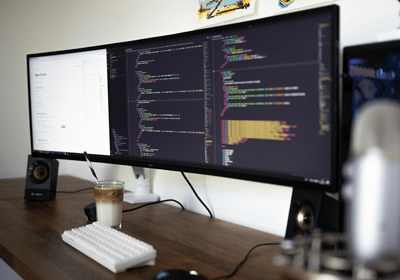
Innovate with AI in Low Code
Unlocking new possibilities with Microsoft’s Power Platform
The digital landscape is evolving at a breakneck pace, and organizations are under immense pressure to keep up with this rapid change. From streamlining internal processes to delivering exceptional customer experiences, the need for innovation has never been more critical. However, innovation often comes with its own set of challenges—limited resources, technical complexities, and the need for speed can hinder a company’s ability to stay ahead.
This is where the power of low-code platforms comes into play. By simplifying the development process and making it accessible to a broader range of people within an organization, low code can be the catalyst that drives your digital transformation. Now, when you pair low-code development with artificial intelligence (AI), you’re not just innovating—you’re revolutionizing the way your business operates. AI-infused low-code solutions can automate complex tasks, provide predictive insights, and create personalized experiences, all while reducing the need for extensive technical expertise. In this blog post, we’ll explore how Microsoft’s Power Platform enables businesses to innovate with AI in low code and how you can leverage this powerful combination to transform your organization.
What is Low Code?
At its core, low code is a visual approach to software development that allows users to create applications with minimal hand-coding. Traditional software development requires significant time, effort, and expertise. Developers must write complex code, test it, debug it, and then deploy it. This process can be slow and cumbersome, especially when business needs are constantly evolving. Low-code platforms, on the other hand, use drag-and-drop interfaces, pre-built templates, and reusable components to speed up the development process.
But low code isn’t just about speed; it’s about empowerment. With low-code platforms, business users—often referred to as “citizen developers”—can take an active role in creating the tools they need to do their jobs more effectively. This democratization of app development means that IT departments are no longer the sole gatekeepers of innovation. Instead, they can focus on more strategic initiatives while enabling other departments to build their own solutions.
Consider These Examples…
Low code is not just a trend—it’s a strategic advantage that allows businesses to respond quickly to changing demands, innovate faster, and empower their teams. And when you add AI to the mix, the possibilities expand exponentially. AI in low code can automate decision-making, analyze data at scale, and create intelligent, adaptive applications that continuously improve over time. As we dive deeper into Microsoft’s Power Platform, you’ll see how these tools can help you unlock the full potential of AI in your low-code development efforts.
Innovating with AI
Now, imagine combining the simplicity of low code with the power of artificial intelligence. The possibilities are endless! AI can enhance your low-code applications by adding intelligence and automation to your processes. From predictive analytics to natural language processing, AI can help you make smarter decisions, automate routine tasks, and provide a more personalized experience for your customers.
Exploring the Microsoft Power Platform
Microsoft’s Power Platform is at the forefront of the low-code revolution, offering a suite of tools that empower businesses to innovate with AI. Here’s a look at some of the key components:

Power Apps
Power Apps is the foundation of your low-code journey. It allows you to build custom apps tailored to your business needs without extensive coding. With AI Builder, you can easily integrate AI models into your apps, such as object detection, sentiment analysis, and text recognition.

Copilot Studio
Copilot Studio is where AI truly shines. This tool allows you to build AI-driven applications that interact with users in a conversational way. Think of it as your AI assistant that can help users navigate your app, answer questions, and provide recommendations.

Power Pages
Power Pages enables you to create secure, data-driven websites with a low-code approach. When combined with AI, these pages can offer personalized experiences, such as dynamically displaying content based on user behavior or integrating chatbots powered by natural language processing to engage visitors in real time.

Power Automate
Automation is the key to efficiency, and Power Automate (formerly known as Microsoft Flow) helps you automate repetitive tasks and workflows. By integrating AI into your automations, you can create workflows that not only execute tasks but also make decisions based on data.
Why Innovate with AI in Low Code?
The combination of AI and low code isn’t just about building apps faster—it’s about building smarter. By integrating AI into your low-code solutions, you can unlock new capabilities that were previously out of reach. Whether it’s automating complex workflows, providing personalized customer experiences, or making data-driven decisions, AI in low code is the key to innovation.
As a Microsoft Solutions Partner, we’re here to help you navigate this exciting landscape. Whether you’re new to the Power Platform or looking to enhance your existing applications with AI, we’ve got the expertise to guide you every step of the way.
Ready to innovate? Let’s explore how AI in low code can transform your business today.



